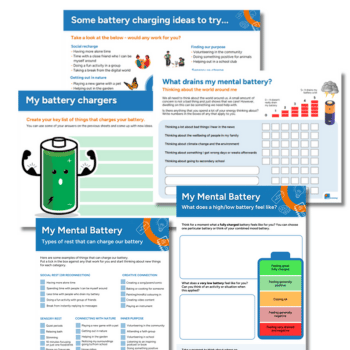“I no longer wanted to be alive” – Could compassion-focused therapy save mental health in schools?

Depression and anxiety drove Andy Sammons to the brink – but compassion focused therapy helped him back. Could it work for our whole school system?

- by Andy Sammons
- Head of teaching and learning at Bedrock Learning

I should have acted at the first sign of trouble. A perfectly innocent email dropped in my inbox, and I cried. A lot. For about 10 minutes.
I turned 32 last year, I have a beautiful two-year-old and an incredible wife. But at that point I found myself lying on my parents’ couch and sobbing uncontrollably. It’s safe to say that 2018 was an appalling year for me.
Without knowing how I got there, I had plummeted into a black hole of depression and anxiety so deep that I no longer wanted to be alive.
When my little boy cried, my stomach would lurch with anxiety and panic. The thought of going in to work every day gave me a 10-tonne weight on my chest. Working as a head of department in an unstable environment for months had destroyed my mind’s ability to rationalise.
I was gone, mentally. Totally.
Working my way out of this – and I am continuing to do so – has forced me to consider education in its widest sense, and the systems we find ourselves in.
Two things are abundantly clear: first, the cruellest thing about depression and anxiety is that it is like a living death, but one you can only really fix from inside – albeit with some help from others.
Secondly, if we take a look into the mental health literature and map it onto our educational context in the UK, we see that the system itself is inadvertently encouraging everyone inside it into behaviours which might seem rational, but are profoundly harmful to their own – and others’ – mental wellbeing.
An evolved approach
At my lowest point, I sought help from a therapist. She drew three circles on a sheet of paper – the same sheet of paper that remains on the table whenever I see her now.
Each of the circles had a word inside of it: Threat, Soothe and Drive.
The approach we have used is called Compassion Focused Therapy, and it has roots in evolutionary psychology.
We have three parts in our brain: a ‘threat’ part, which is the most basic and powerful of our evolved brains (from our reptilian days); a ‘drive’ part linked with status and achievement (coming in during our mammalian days); and then a more recently evolved ‘soothe’ part (more directly linked with humans – linked to attachment, kindness, care and affection).
In effect, when we perceive threats in our environment, it basically triggers a panic state in the brain which can have long lasting and appalling consequences for our mental health.
As the most powerful part of the brain, the threat system has the override – much like a fire alarm whose only job is to get people out of a building.
Unfortunately, it’s not so great at finding answers to complex solutions – it’s much better at telling us to run from tigers, I suppose.
Our bodies even tell us when we’re in threat mode – palpitations, sweating, breathlessness and that awful feeling in the pit of your stomach or chest may sound familiar…
Everything in our society – and I include education in this – is pretty much structured in a way that encourages us to forget that we are evolved beings whose brains aren’t evolved solely to meet the challenges of modern living.
And unless we consciously remind ourselves of this and make space between ourselves and our thoughts, feelings and emotions, we are in for a tricky ride.
Evolution is the most awesome power imaginable; luckily for us, it built a failsafe into our minds, too. If we nurture our human ‘soothe’ brain, we can calm our systems, promoting not only more effective mental health, but also more effective environments for us to work within.
Systemic issues
When I realised the model I’d been working with was about ‘compassion’ my heart sank: I didn’t want to be told to be nice to myself and others and it would all be OK. But I was wrong.
Compassion is about honesty and warmth – not just ‘being nice’. It actually speaks to the ‘soothe’ brain by encouraging us to speak to ourselves in a kind and honest way, and listening to some of the unhelpful things a ‘threat addled’ brain might be telling us.
By understanding ourselves – and being kinder in the process – we can begin to understand the point of departure of others – both colleagues and students alike. We are specifically evolved to benefit from kindness, and to give it to others too.
This got me thinking: does this apply to wider systems, and not just the individual?
What if we’re living on the threat/drive access with no outlet?
What if – as a system – education is forcing us to focus on outcomes and external measures to justify our own existence?
What if schools’ validation comes only from external sources such as exam results rather than the quality of relationships that happen inside the building?
Pressures on headteachers and their staff to conform to a competition-based model of education with league tables at their heart has led to exactly the reverse of healthy mental behaviours at a systemic level.
Schools should be about soothe/drive – the desire to achieve should be driven from a compassionate and warm place.
A Threat-Drive school starts from the wrong place, and leads to altogether more appalling consequences.
Start here
Moving forward, there is absolutely a way out of the quagmire. To a degree, change at a systemic level is out of our control; however, we can genuinely begin a cultural shift if we start with ourselves.
It begins by seeing ourselves as part of a much bigger picture in terms of the systems that might be exerting pressure on us.
If we collectively do this, we can begin to create the schools our teachers and young people deserve.
As individuals, we can begin by practising things like Soothing Rhythm Breathing to calm ourselves (look it up- there’s loads of free guides online), being conscious of things we appreciate in our lives, and even just noticing how we feel, and the triggers that may be leading to this.
Sometimes, the honesty we provide ourselves can tell us things we might not want to hear in terms of leaving our schools if they are detrimental to our wellbeing. The point is this: unless we are prepared to recognise our own warning signs and do something about it individually and collectively, things will only get worse.
It starts with you
Using his own experiences as a starting point, Andy has researched and written a book – The Compassionate Teacher – which is an exploration and an explanation of how individuals working within schools can improve their own mental health.
It also offers some practical tips from a teaching perspective to help educators maintain an impactful yet manageable work-life balance. Find out more, and order a copy, at here.
Andy Sammons leads English in a large secondary comprehensive in West Yorkshire. He tweets at @andy_samm. The Compassionate Teacher is published by John Catt.










